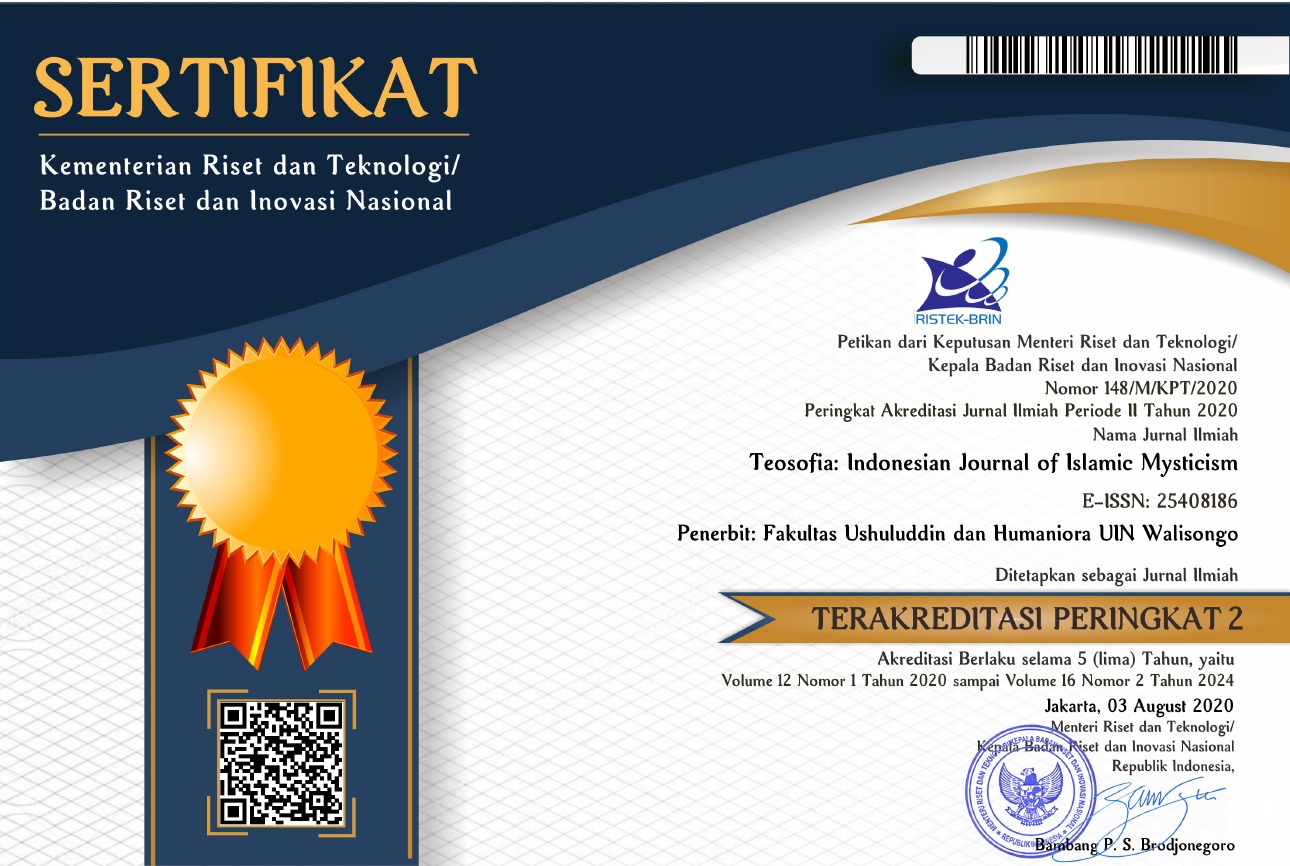Tuhfah al-Mursalah ila Ruh al-Nabiy as the Source of the Doctrine Seven Grades of Being in the Malay-Indonesian Archipelago
DOI:
https://doi.org/10.21580/tos.v10i1.8580Keywords:
Al-Tuḥfa al-Mursala, Fadlullah al-Burhanpuri, Ibn ʿArabī, Martabat Tujuh, Unity of BeingAbstract
The ‘doctrine of the seven grades’ or martabat tujuh is a popular Sufi teaching. It originated in early seventeenth-century India and was later introduced in Aceh and gained considerable popularity among the Malay Sufis. Despite its wide acceptance in Sufi circles, martabat tujuh seems incompatible with Islam and its strict belief in a transcendent God. The purpose of this article is to examine the history of the Tuḥfa al-Mursala as the source text of this doctrine and to establish its authenticity as a legitimate source of Sufi thought in Southeast Asia. Based on detailed document analysis, the study found that its original purpose was to correct misconceptions of Ibn ʿArabī’s waḥdat al-wujūd. The text is attributed to Fadlullah al-Burhanpuri, an eminent Sufi scholar living in the seventeenth century. The Tuḥfa al-Mursala and its commentaries are an important source for the study of Sufi thought in the archipelago and the doctrine of martabat tujuh.Downloads
References
Abdullah, Abdul Rahman. Pemikiran Umat Islam Di Nusantara. Kuala Lumpur: Dewan Bahasa & Pustaka, 1990.
Al-Attas, Syed Muhammad Naquib. The Mysticism of Hamzah Fansuri. Kuala Lumpur: University Malaya Press, 1970.
Al-Banjari, Muhammad Nafis b. Idris. Al-Durru’l-Nafis Fi Bayani Wahidati’l-Af`al Wa’l-Asma’i Wa’l-Sifati Wa’l-Dhat. Penang: al-Ma`arif, n.d.
Al-Palimbani, Abdul Samad al-Jawi. Sair Al-Salikin Ila `Ibadat Rabb Al-`Alamin. Vol. 4. Cairo, 1953.
Ansari, Muhammad Abdul Haq. Sufism and Shari`ah: A Study of Shaykh Ahmad Sirhindi’s Effort to Reform Sufism. Leicester, UK: The Islamic Foundation, 1986.
Azra, Azyumardi. Jaringan Ulama Timur Tengah Dan Kepulauan Melayu Abad XVII Dan XVIII. Bandung: Mizan, 1995.
———. The Origins of Islamic Reformism in Southeast Asia. Networks of Malay-Indonesian and Middle Eastern ’Ulamā’ in the Seventeenth and Eighteenth Centuries. Southeast Asia Publications Series. Honolulu: University of Hawaii Press, 2004.
Badaruddin, Faudzinaim. Manhal Al-Safi: Text and Translation. Bangi: Department of Theology and Philosophy, 2006.
———. “Peranan Kitab Jawi Tasawuf Sebagai Medium Transmisi Ilmu Islam Kepada Masyarakat Melayu Nusantara.” International Journal of Islamic Thought 1, no. 1 (2012): 19–26. doi:10.24035/ijit.01.2012.003
Chodkiewicz, Michel. “The Diffusion of Ibn Arabi’s Doctrine.” Journal of the Muhyiddin Ibn Arabi Society 9 (1991). https://ibnarabisociety.org/the-diffusion-of-ibn-arabis-doctrine-michel-chodkiewicz/.
Drewes, G.W.J. “Nur Al-Din Ar-Raniri’s Charge of Heresy against Hamzah and Shamsuddin from an International Point of View.” In Cultural Contact and Textual Interpretation, edited by C.D. Grijns and S.O. Robson. Dordrecht: Foris, 1986.
Drewes, G.W.J., and Anthony H. Johns. “Malay Sufism as Illustrated in an Anonymous Collection of 17th Century Tracts.” Journal of the Malayan Branch of the Royal Asiatic Society XXX, no. 178 (1957). https://www.jstor.org/stable/i40073638.
Fathurahman, Oman. “Itḥāf Al-Dhakī by Ibrāhīm Al-Kūrānī: A Commentary of Waḥdat Al- Wujūd for Jāwī Audiences.” Archipel 81, no. 1 (2011): 177–98. https://doi.org/10.3406/arch.2011.4274.
Hussain, Yusuf. Glimpses of Medieval Indian Culture. London: Asia Publishing House, 1959.
Johns, Anthony H. “Daka’ik Al-Huruf by Abdul Rauf of Singkel.” Journal of Royal Asiatic Society, 1955. https://www.scribd.com/document/425766864/Abd-Al-Rauf-Dakaik-Al-huruf.
———. “Friends in Grace: Ibrahim Al-Kurani and `Abd Al-Ra’uf of Al-Singkili.” In Spectrum: Essays Presented to S. Takdir Alisjahbana on His 70th Birthday, edited by Udin S. Jakarta: Dian Rakyat, 1978.
———. “Islamization in Southeast Asia: Reflections and Reconsiderations with Special Reference to the Role of Sufism.” Southeast Asian Studies 31, no. 1 (1993): 43–61. https://repository.kulib.kyoto-u.ac.jp/dspace/bitstream/2433/56487/1/KJ00000131747.pdf
———. “Muslim Mystics and Historical Writings.” In Historians of South East Asia, edited by D. G. E. Hall. London: Oxford University Press, 1963.
———. “Nur Al-Daka’ik By the Sumatran Mystic Shamsu l-Din Ibn `Abdullah.” Journal of Royal Asiatic Society, 1953. https://www.jstor.org/stable/25222649.
———. The Gift Addressed to the Spirit of the Prophet. Canberra: Australia National University, 1965.
Jumat, Matussein Haji. “The Doctrine of Wahdatul Wujud: The Issue of Contamination of the Study of Islamic Sufism with Greek Philosophy.” Journal of Social Transformation and Regional Development 2, no. 3 (2020): 214–21. https://publisher.uthm.edu.my/ojs/index.php/jstard/article/view/8028
Kurniawan, Ade Fakih. “Konsep ’Awalim ’Abd Allah Bin ’Abd Al-Qahhar Al-Bantani Dalam Diskursus Wujudiyyah Di Nusantara.” Al-Qalam 28, no. 3 (January 31, 2019): 419–48. https://doi.org/10.32678/alqalam.v28i3.1060.
Mansur, H.M. Laily. Kitab Ad-Durun Nafis: Tinjauan Atas Suatu Ajaran Tasawuf. Banjarmasin: Hasanu, 1982.
Nieuwenhuijze, Christoffel A.O. van. Samsu ’L-Din van Pasai: Bijdrage Tot de Kennis Der Sumatraanche Mystiek. Leiden: E.J. Brill, 1945.
Riddell, Peter. Transferring a Tradition: `Abd Al-Ra’uf Al-Singkili’s Rendering Into Malay of the Jalalayn Commentary. Monograph 31. California: Center for South and Southeast Asia Studies University of California at Berkeley, 1990.
Risvi, Saiyid Athar Abbas. A History of Sufism in India. Vol. 2. New Delhi: Munshiram Manoharlal Publishers, 1983.
Saghir, Wan Muhammad. Khazanah Karya Pusaka Asia Tenggara. Vol. 2. Kuala Lumpur: Khazanah Fathaniyah, 1991.
Santri, Aliefya M. “Martabat (Alam) Tujuh: Satu Naskhah Mistik Islam Dari Desa Karang, Pamijahan.” In Warisan Intelektual Islam Indonesia, edited by Ahmad Rifa`i Hasan. Bandung: Mizan, 1987.
Schimmel, Annemarie, Mystical Dimensions of Islam, USA: The University of South Carolina Press, 1975.
Downloads
Published
How to Cite
Issue
Section
License
Copyright
The copyright of the received article shall be assigned to the journal as the publisher of the journal. The intended copyright includes the right to publish the article in various forms (including reprints). The journal maintains the publishing rights to the published articles. Therefore, the author must submit a statement of the Copyright Transfer Agreement.*)
Licensing

This work is licensed under a Creative Commons Attribution-ShareAlike 4.0 International License.
In line with the license, authors are allowed to share and adapt the material. In addition, the material must be given appropriate credit, provided with a link to the license, and indicated if changes were made. If authors remix, transform or build upon the material, authors must distribute their contributions under the same license as the original.
_______
*) Authors whose articles are accepted for publication will receive confirmation via email and send a Copyright Transfer Agreement.








